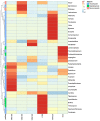Oral Mycobiome Differences in Various Spatial Niches With and Without Severe Early Childhood Caries
- PMID: 34869106
- PMCID: PMC8634708
- DOI: 10.3389/fped.2021.748656
Oral Mycobiome Differences in Various Spatial Niches With and Without Severe Early Childhood Caries
Abstract
Purpose: Severe early childhood caries (S-ECC) is a microbe-mediated disease with tooth hard tissue destruction. However, the role of the fungal community in various ecological niches of deciduous dental caries has not been fully elucidated. This study aimed to analyze the differences of mycobiome in diverse spatial niches with and without S-ECC. Method: A total of 48 samples were obtained from 8 S-ECC children (SE group) and 8 caries-free children (CF group) aged 4-5 years. Unstimulated saliva (S), healthy supragingival plaque (FMIX), mixed plaque from decayed teeth (SMIX) and carious lesion (DMIX) samples were collected. The ITS2 region of the fungi was amplified and sequenced using the Ion S5™XL platform. Results: A total of 281 species were identified. Candida albicans showed relatively higher abundance in S-ECC children, while Alternaria alternata and Bipolaris sorokiniana were more enriched in CF group. In this study, the relative abundance of C. albicans in CF.FMIX (0.4%), SE.FMIX (12.5%), SE.SMIX (24.0%), and SE.DMIX (37.2%) increased successively. Significant differences of fungal species richness and diversity were observed between SE.FMIX-SE.SMIX, SE.FMIX-SE.DMIX (P < 0.05). Conclusions: The diversity of fungal communities in S-ECC children showed significant differences in various spatial niches of primary teeth. The richness of C. albicans was closely related to the caries states and depth, suggesting that it may play a crucial role in caries pathogenicity.
Keywords: ITS2; S-ECC; dental plaque; mycobiome; saliva.
Copyright © 2021 Cui, Wang, Zhang, Pang, Zhou, Lin and Tao.
Conflict of interest statement
The authors declare that the research was conducted in the absence of any commercial or financial relationships that could be construed as a potential conflict of interest.
Figures




References
-
- GBD 2017 Disease and Injury Incidence and Prevalence Collaborators . Global, regional, and national incidence, prevalence, and years lived with disability for 328 diseases and injuries for 195 countries, 1990-2016: a systematic analysis for the Global Burden of Disease Study 2016. Lancet. (2018) 390:1211–59. 10.1016/s0140-6736(17)32154-2 - DOI - PMC - PubMed
-
- American Academy on Pediatric Dentistry American Academy of Pediatrics . Policy on early childhood caries (ECC): classifications, consequences, and preventive strategies. Pediatr Dent. (2008) 30(Suppl. 7):40–3. - PubMed
-
- Dye BA, Thornton-Evans G, Li X, Iafolla TJ. Dental caries and sealant prevalence in children and adolescents in the United States, 2011-2012. NCHS Data Brief. (2015) 191:1–8. - PubMed
LinkOut - more resources
Full Text Sources

